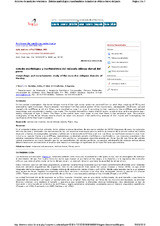Mostrar el registro sencillo del ítem
Estudio morfológico y morfométrico del músculo oblicuo dorsal del perro
| dc.contributor.author | Vivo Rodríguez, J. | |
| dc.contributor.author | Morales López, J.L. | |
| dc.contributor.author | Diz Plaza, A.M. | |
| dc.contributor.author | Martínez Galisteo, A. | |
| dc.contributor.author | Agüera Carmona, Eduardo | |
| dc.date.accessioned | 2013-08-29T10:27:30Z | |
| dc.date.available | 2013-08-29T10:27:30Z | |
| dc.date.issued | 2005 | |
| dc.identifier.uri | http://hdl.handle.net/10396/10867 | |
| dc.description.abstract | In the present investigation, the dorsal oblique muscle of the right ocular globe was removed from six adult dogs weighing 40-50 kg and analyzed by light microscopy. Muscle samples were taken from the central portion of the muscle belly, subsequently ultrafrozen, cut and stained with m-ATPase at pH 4.6. Fibers were classified as type I or type II according to their reaction to the m-ATPase and detailed morphologic and morphometric studies were made. The muscles showed two clearly distinct layers, a central layer and a peripheral layer, mainly composed of type II fibers. The fibers in the central layer were larger in size than those in the peripheral layer. The peculiar stratigraphy of the dorsal oblique muscle should be taken into account when performing analyses of this muscle and investigating the significance of the fiber types it contains. | es_ES |
| dc.description.abstract | En el presente trabajo se han extraído, de los globos oculares derechos, de seis perros adultos de 40-50 kilogramos de peso, los músculos oblicuos dorsales y analizados con microscopia de luz. Las muestras musculares para su análisis se tomaron de la porción central del vientre muscular y fueron ultracongeladas, cortadas y teñidas por la técnica de m-ATPasa a pH 4,6. Las fibras se clasificaron en tipo I y tipo II en virtud a su reacción frente a la m-ATPasa, realizándose un detallado estudio morfológico y morfométrico. Los músculos presentaron dos estratos netamente diferenciados, uno central y otro periférico, compuestos mayoritariamente por fibras tipo II. Las fibras del estrato central presentaron un mayor tamaño que las correspondientes del estrato periférico. La peculiar estratigrafía del músculo oblicuo dorsal debería tenerse en consideración al analizar este músculo e investigar el significado de los tipos fibrilares que contiene | es_ES |
| dc.format.mimetype | application/pdf | es_ES |
| dc.language.iso | spa | es_ES |
| dc.publisher | Universidad Austral de Chile | es_ES |
| dc.rights | https://creativecommons.org/licenses/by-nc-nd/4.0/ | es_ES |
| dc.source | Archivos de Medicina Veterinaria 37 (1), 49-54 (2005) | es_ES |
| dc.subject | Músculos extraoculares | es_ES |
| dc.subject | Oblicuo dorsal | es_ES |
| dc.subject | Perros | es_ES |
| dc.subject | Extraocular muscles | es_ES |
| dc.subject | Dorsal oblique muscle | es_ES |
| dc.subject | Dog | es_ES |
| dc.title | Estudio morfológico y morfométrico del músculo oblicuo dorsal del perro | es_ES |
| dc.title.alternative | Morphologic and morphometric study of the musculus obliquus dorsalis of the dog | es_ES |
| dc.type | info:eu-repo/semantics/article | es_ES |
| dc.relation.publisherversion | http://www.scielo.cl/scielo.php?script=sci_arttext&pid=S0301-732X2005000100007&lng=es&nrm=iso&tlng=es | |
| dc.rights.accessRights | info:eu-repo/semantics/openAccess | es_ES |

